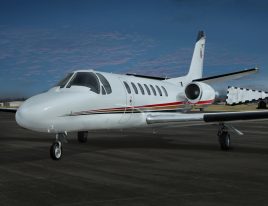Citation Ultra - Description
Cessna’s aim of producing simple, economical business jets is met in the Citation Ultra. Few private jets in its class can compare in terms of cabin dimensions, speed, and takeoff distance.
The cabin, which can hold eight passengers, stretches to seventeen feet, five inches – the longest cabin of any light private jet. The strategic use of seamless wall panels, indirect lights, and mirrors make the cabin seem even more spacious. Passengers enjoy the cabins equipped with individual flat panel entertainment systems and audio jacks (an optional feature). The Ultra has storage space for twenty-six cubic feet of baggage, or about six hundred pounds worth of golf bags, suitcases, or whatever else worth bringing along.
Arguably the best selling point of the Ultra is its short takeoff distance. The Ultra can complete a takeoff in just 3,200 feet while loaded to its maximum takeoff weight of 16,300 pounds. Not only is the Ultra quick on takeoff, but it is pretty fast at a cruise altitude of 37,000 feet as well. It has a maximum cruise speed of 426 knots
The Ultra’s speed can be attributed largely to its wing design. Adhering to the Citation line’s tradition of simplicity in design and operation, it uses the fastest straight wing design that the Citation line has ever seen. Two aerodynamicists, one from Cessna and one from NASA, collaborated to redesign the Citation line’s standard straight wing. The result was a wing with a large leading-edge radius and a level upper surface, which better distributed air flow, cut drag, and increased the Ultra’s cruise speed by .08 mach (46 knots).
It would be entirely unfair to solely give credit for the Ultra’s speed to the wing design, as the Pratt & Whitney Canada JT15D-5D turbofan engines provide all of the power. Each engine provides the Ultra with 3,045 pounds of thrust. The blades, made from a single-crystal alloy, are part of a wide-chord blade design that has been refined by computer software to improve aerodynamic characteristics. The new alloy also allows the inner tube temperature to go up an additional 68 degrees Fahrenheit (when compared to the recent JT15D5-5A engines). The engine design cuts down on air leaks, resulting in better aerodynamic efficiency.
The engines produce enough bleed air to support the Ultra’s systems – anti-icing, cabin pressurization and air conditioning. The temperature control system is conveniently designed to allow the cabin and cockpit to set and maintain different temperatures.
When it comes to avionics systems, simplicity is best. The engineers of the Honeywell Primus 1000 suite realized the importance of details like consolidating multiple displays into a few, easy-to-interpret ones and placing screens close to the controls to which they apply. The predecessor of the Ultra had a confusing array of five screens and more than eight analog controls. The Ultra consolidated the mess into four sleek screens. The relevant controls are located directly on the screens’ faceplates to improve pilot hand-eye coordination and flight performance.













